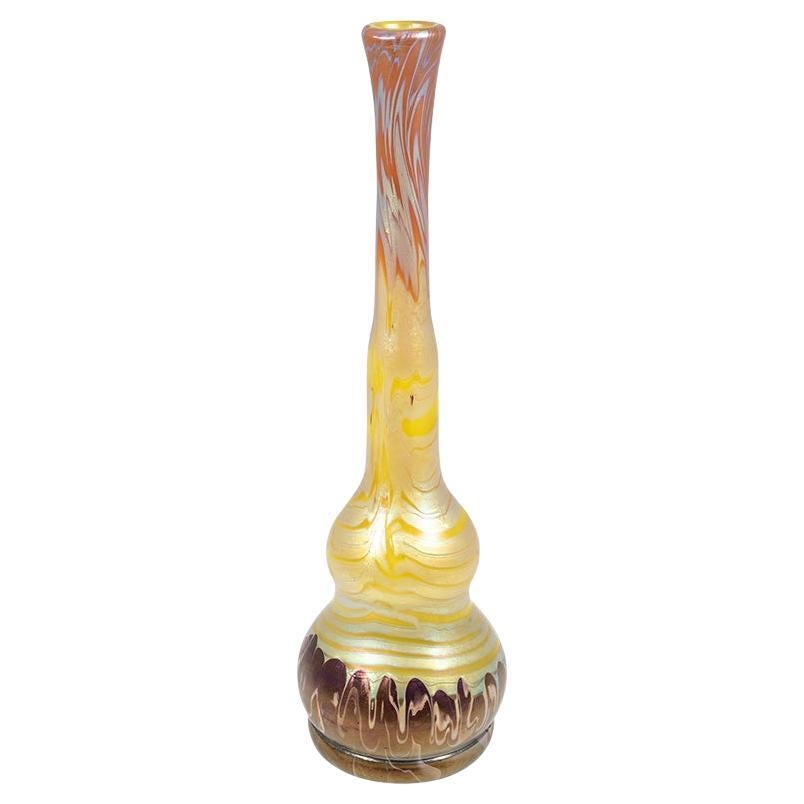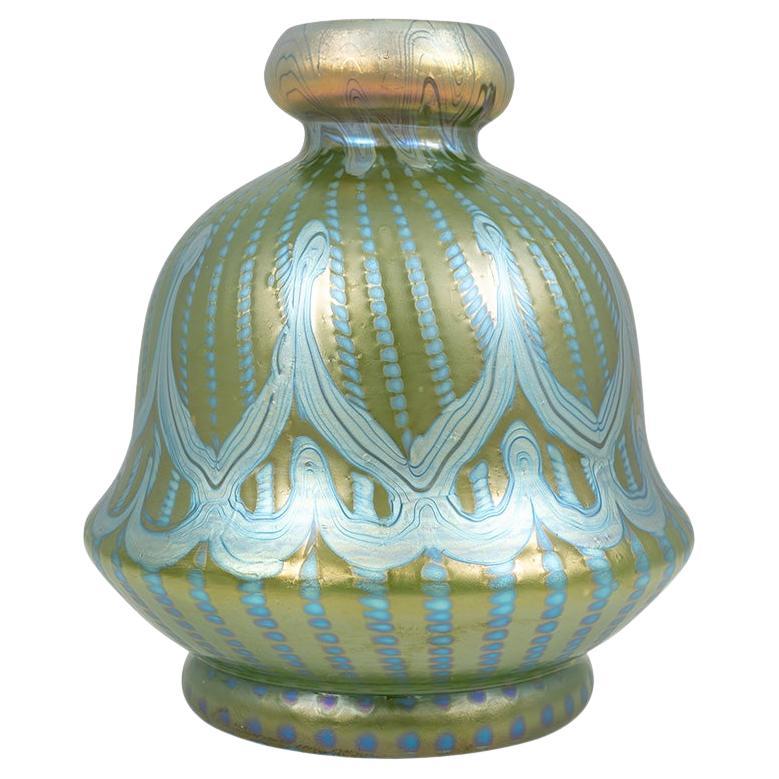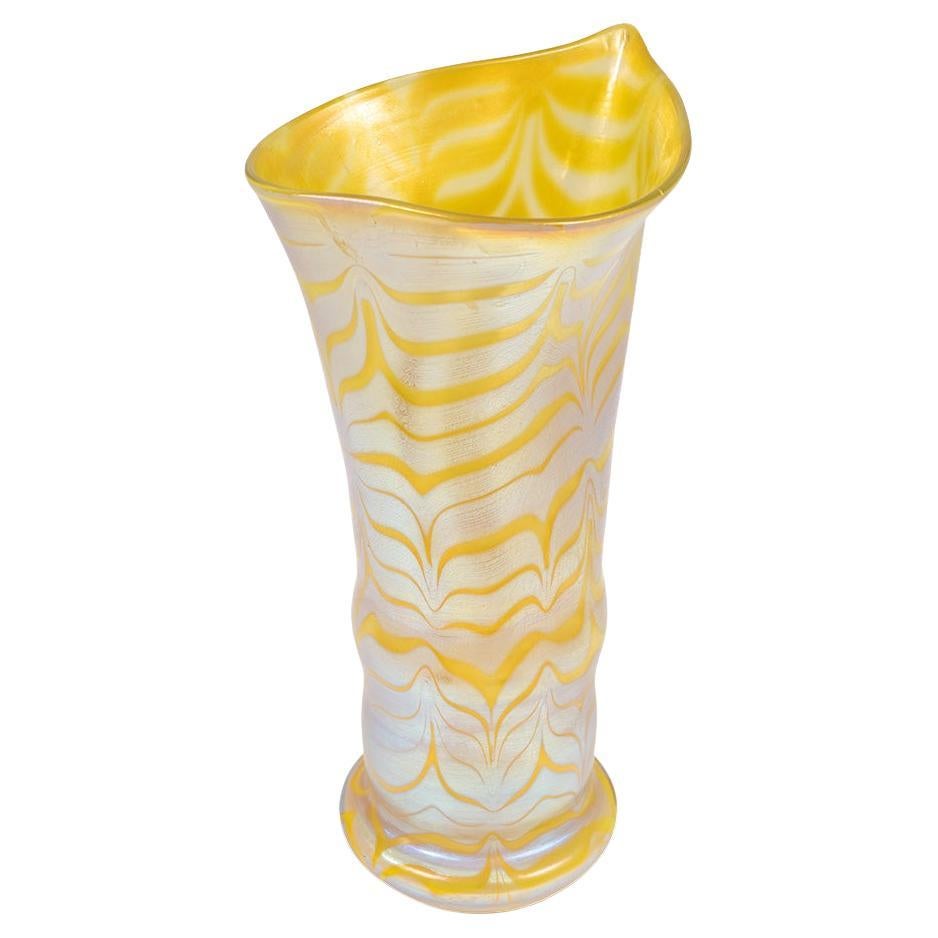Items Similar to Bohemian Glass Vase Loetz circa 1900 Pampas Cobalt Art Nouveau Blue
Want more images or videos?
Request additional images or videos from the seller
1 of 7
Bohemian Glass Vase Loetz circa 1900 Pampas Cobalt Art Nouveau Blue
About the Item
Bohemian glass vase, manufactured by Johann Loetz Witwe, Pampas Cobalt decoration, ca. 1899, Blue, Silver, Viennese Art Nouveau, Jugendstil, Art Deco, art glass, iridescent glass.
Technique and material: Glass, mould-blown and freeform, reduced and iridescent
Bib. : compare A. Adlerova, E. Ploil, H. Ricke, T. Vlcek (ed.), Loetz – Böhmisches Glas 1880-1940, vol. II, paper pattern catalogue, Prestel, Munich 1989,, paper pattern 504, p. 100.
- Creator:Loetz Glass (Manufacturer)
- Dimensions:Height: 12.41 in (31.5 cm)Diameter: 4.73 in (12 cm)
- Style:Jugendstil (Of the Period)
- Materials and Techniques:
- Place of Origin:
- Period:
- Date of Manufacture:circa 1900
- Condition:Wear consistent with age and use.
- Seller Location:Klosterneuburg, AT
- Reference Number:
About the Seller
5.0
Vetted Seller
These experienced sellers undergo a comprehensive evaluation by our team of in-house experts.
Established in 2013
1stDibs seller since 2021
13 sales on 1stDibs
Typical response time: <1 hour
- ShippingRetrieving quote...Ships From: Klosterneuburg, Austria
- Return PolicyA return for this item may be initiated within 14 days of delivery.
More From This SellerView All
- Bohemian Glass Vase Loetz circa 1900 Art Nouveau Jugendstil Blue SilverBy Loetz GlassLocated in Klosterneuburg, ATBohemian glass vase, manufactured by Johann Loetz Witwe, Norma Cobalt decoration, ca. 1900, Paris World Exhibition, Blue, Silver, Yellow, Viennese Art Nouveau, Jugendstil, Art Deco, ...Category
Early 20th Century Austrian Jugendstil Glass
MaterialsGlass
- Bohemian Glass Vase Loetz PG 358 circa 1900 Art NouveauBy Loetz GlassLocated in Klosterneuburg, ATAustrian Jugendstil glass vase manufactured by Johann Loetz Witwe, Phenomen Genre 358 decoration, circa 1900 This glass vase is an extraordinary example of the Loetz manufactory its...Category
Early 20th Century Austrian Jugendstil Glass
MaterialsGlass
- Bohemian Glass Vase Loetz PG 358 circa 1900 Art NouveauBy Loetz GlassLocated in Klosterneuburg, ATAustrian Jugendstil glass vase manufactured by Johann Loetz Witwe, Phenomen Genre 358 decoration, circa 1901 This glass vase is an extraordinary example of the Loetz manufactory its...Category
Early 20th Century Austrian Jugendstil Glass
MaterialsGlass
- Bohemian Glass Vase Loetz circa 1900 Signed Art Nouveau Jugendstil Blue GreenBy Loetz GlassLocated in Klosterneuburg, ATBohemian glass vase, manufactured by Johann Loetz Witwe, unidentified decoration, ca. 1900, Blue, Silver, Green, Viennese Art Nouveau, Jugendstil, Art Deco, art glass, iridescent gla...Category
Early 20th Century Austrian Jugendstil Glass
MaterialsGlass
- Bohemian Glass Vase Loetz circa 1900 Art Nouveau Jugendstil Yellow SignedBy Loetz GlassLocated in Klosterneuburg, ATBohemian glass vase, manufactured by Johann Loetz Witwe, Phenomen Genre 85/3780 decoration, signed, ca. 1900, Yellow, Silver, Viennese Art Nouveau, Jugendstil, Art Deco, art glass, i...Category
Early 20th Century Austrian Jugendstil Glass
MaterialsGlass
- Bohemian Glass Vase Loetz circa 1900 Flower Art Nouveau Jugendstil Green RedBy Loetz GlassLocated in Klosterneuburg, ATBohemian glass vase, manufactured by Johann Loetz Witwe, Opal verlaufend mit grünen Blättern und rother Blume decoration, ca. 1900, Flower, Blue, Silver, Green, Viennese Art Nouveau,...Category
Early 20th Century Austrian Jugendstil Glass
MaterialsGlass
You May Also Like
- Vase Loetz , Style : Art Nouveau , Bohemia, circa 1900By Loetz GlassLocated in Ciudad Autónoma Buenos Aires, CLoetz The glass factory, originally founded in 1836 by Johann Baptist Eisner, was taken over. Loetz was the premier Bohemian glass works during this period. It was located in Klostermühle, near Rejštejn in the Sušice district in South-West Bohemia, which belonged to the Austro-Hungarian Empire until 1918. Susanna Loetz, widow of Glass entrepreneur Johann Loetz in 1852. She renamed the company "Glasfabrik Johann Loetz Witwe", a name that was retained until all activities were stopped in 1947. In 1879 it passed to Max Ritter von Spaun. Under his guidance, together with director Eduard Prochaska, the glassworks flourished as never before and enjoyed its most successful period. Von Spaun and Prochaska concentrated on the development of innovative glass types and new production techniques. Their first successful speciality was a glass type simulating semiprecious stones. It is often called "Marmoriertes Glas" ("marbled glass"). The range contained Onyx (red/brown), Karneol (red/pink) and later Malachit (green). It was introduced in the second half of the 1880's. From the same period dates the Octopus glass, of which the decor resembles the tentacles of a cephalopod. The production of Marmorier-tes Glas was resumed in 1906, in different colours like yellow and white. Octopus, 1885-1890, 1885-1890, unknown, an Malachit, 1885-1890, unknown, The master glass-blowers of Klostermühle had already carried out experiments with iridescence in the first half of the 1890's, and they produced the Olympia, a classically inspired olive green type, in 1896. Similar, in variants of creta green, bronce or Olympia and averse to any redundant decoration was the Glatt decor. It highly contrasted with the more elaborate finishes of that time, but it constitutes a part of the production with a deep sense for taste and quality. Most of the pieces shown in the "Glatt" decors were manufactured for Max Emmanuel in London. The glatt decor remained in use for many years. The Chiné decor had thin glass threads spun around the body in irregular patterns. It is not to be confused with the type of glass that was produced by Kralik. Loetz "Chiné" came in clear, opal, green and pink, Kralik "Chiné" in dark purple. The logical sequel to Chiné was the Pampas decor, green or cobalt blue, in which the threads almost disappeared in the surface, with iridised parts in between. Around the same time the dotted Papillon decor was introduced. The beautiful silver spots were employed on a wide array of models and quite effective on the gooseneck (water sprinkler) and sea shell...Category
Antique Early 1900s Austrian Art Nouveau Glass
MaterialsArt Glass
- Loetz Art Nouveau Vase Cobalt Papillon with Applied Butterflies, Ca 1900By Loetz GlassLocated in Vienna, ATFinest Bohemian Art Nouveau glass vase: Mould-blown vase with torus-shaped stand and funnel-shaped attached wall with trefoil-shaped, lobed mouth rim, wall and inside satin-finished, polished pontil. Shape: Production number / pattern not preserved Decor: Cobalt Papillon...Category
Antique Early 1900s Austrian Art Nouveau Glass
MaterialsGlass
- Vase Loetz Widow Klostermuehle Bohemia Art Nouveau Creta Pampas before 1902By Loetz GlassLocated in Vienna, ATVASE LOETZ (LÖTZ) WIDOW KLOSTERMUEHLE BOHEMIA ART NOUVEAU Made by Loetz, Klostermuehle (Bohemia), before 1902 Decor: CRETA PAMPAS BLUE-GREEN It is an elegant Loetz Art Nouveau ...Category
Antique Late 19th Century Austrian Art Nouveau Glass
MaterialsGlass
- Bohemian Loetz Art Deco Cobalt Papillon Footed Glass Vase c1920By Loetz GlassLocated in Worcester Park, GBA fabulous Art Deco Cobalt (blue/gold on blue) Papillon (Butterfly wing) footed vase. This iridised finish was first created by Loetz in 1898, but the pattern was revised in the earl...Category
Vintage 1920s Czech Art Deco Glass
MaterialsArt Glass
- Loetz Art Nouveau Vase Cobalt Mimosa With 3 Handles, Austria-Hungary, circa 1911By Loetz GlassLocated in Vienna, ATBlown, flat, bulbous body on a large, round, flush stand, contracting to a short, wide neck, slightly widened, 6-fold wavy indented mouth rim. Cobalt blue underlay with silver-yellow...Category
Vintage 1910s Austrian Art Nouveau Glass
MaterialsGlass
- Loetz Art Nouveau Vase Cobalt Mimosa with 2 Handles, Austria-Hungary, circa 1909By Loetz GlassLocated in Vienna, ATForm blown baluster-shaped body on a round, flush stand, bulbously widening and contracting to a short, wide neck. Cobalt blue underlay with silver-yellow-green crumb inclusions, 2 s...Category
Antique Early 1900s Austrian Art Nouveau Glass
MaterialsGlass





